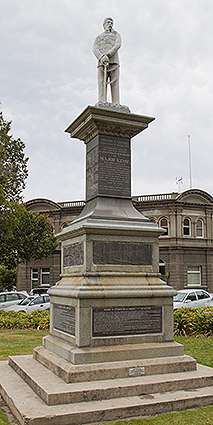Moutoa Gardens


Moutoa Gardens, also known as Pākaitore, is a park in the city of Whanganui, New Zealand. Named after the Battle of Moutoa Island in the Second Taranaki War, it contains a memorial to the battle inscribed "To the memory of the brave men who fell at Moutoa, 14 May 1864, in defence of law and order against fanaticism and barbarism."[1] It also contained a statue of John Ballance, organiser of a volunteer cavalry troop in Titokowaru's War and later Premier of New Zealand.
Historically, Pākaitore was a traditional fishing settlement for hundreds of years and later became a marketplace. The area was considered a sanctuary where all tribes were equal and the police could not enter. Between 1839 and 1848 the New Zealand Company purchased Wanganui lands on behalf of the crown from people and tribes who may have had little or no claim to it.[2]
The park was occupied for 79 days in 1995 in protest over a Treaty of Waitangi claim, an action which split the town and the nation and garnered significant attention from police.[3] Local iwi claim the site was the location of a pa and trading site, left to Māori in the 1848 sale of Wanganui. Leading up to the protest the statue of Ballance was beheaded; a replacement Ballance statue was commissioned in 2009 and placed outside the Wanganui District Council buildings.[4]
The most prominent monument at Moutoa Gardens today honours Te Keepa Te Rangihiwinui NZC, a Māori military commander and noted ally of the government forces during the New Zealand Wars. First known as Te Rangihiwinui and later as Major Kemp, he led the government allied Māori forces who defeated the rebel Māori at Moutoa Island. The inscription on the plinth says the monument was erected by the people of New Zealand to honour the "high-born Maori chief, brave soldier and staunch ally of the New Zealand Government".
References
- ↑ James Cowan (1956). The New Zealand Wars: A History of the Maori Campaigns and the Pioneering Period: Volume II: The Hauhau Wars, 1864–72, Chapter 3: THE BATTLE OF MOUTOA. R. E. Owen, Government Printer, Wellington. First published 1923. Reprinted without amendment 1956. Accessed 2007-06-12.
- ↑ "A new wave of Maori activism | Green Left Weekly". Greenleft.org.au. 1995-04-12. Retrieved 2015-08-11.
- ↑ "6/5/95 - Maori Protesters End 79-Day Land Occupation". The Militant. 1995-06-05. Retrieved 2015-08-11.
- ↑ "John Ballance statue; Chris Elliott; 2009 - Wanganui District Council Public Art and Memorials on NZMuseums". Nzmuseums.co.nz. 2013-06-04. Retrieved 2015-08-11.
Coordinates: 39°55′54″S 175°03′24″E / 39.9318°S 175.0568°E